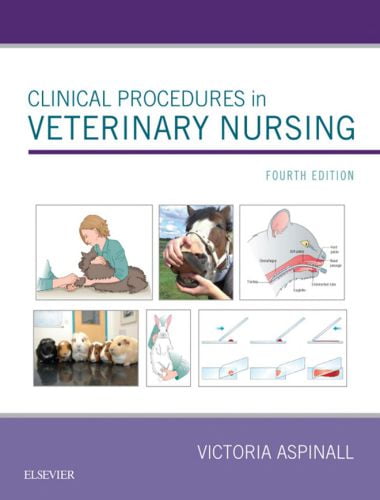Clinical Procedures in Veterinary Nursing 4th Edition by Victoria Aspinall March 2019, The new fourth edition of Clinical Procedures retains the popular format that has been so successful in establishing previous editions.
Clinical Procedures in Veterinary Nursing 4th Edition

All the principal procedures a nurse is likely to be called on to perform are presented in the most practically useful way, linking the action with the underlying rationale and illustrating both with ultra-clear line artworks and photographs. This new edition brings the text into line with the Day One Skills and Competencies which now govern training of veterinary nurses, with revision and updating throughout.
- All the principal basic procedures are covered
- Uses a step-by-step ‘action/rationale’ approach for maximum clarity
- Covers companion animals, equine and exotic species
- Never struggle to find definitive information on basic procedures again
- A reference guide to best practice for both qualified and trainee veterinary nurses and veterinary technicians
- All skills reviewed and updated in conformity with best practice
- Now aligned with RCVS Day One current skills and competencies
- Includes self-assessment questions on each chapter
- All-new design improves user-friendliness
- Chapters 4-6 restructured with new illustrations
- Now with new contributors
The third edition of Clinical Procedures in Veterinary Nursing was published in 2014, so it is now time to update the text in line with both changes in veterinary practice and changes in what it is expected of a newly qualified veterinary nurse, namely the Royal College of Veterinary Surgeons (RCVS) Day One Competences. These are broken down into the RCVS Day One Skills list, which describes in detail the essential clinical skills that a veterinary nurse should be capable of carrying out on the day she/he qualifies. The skills list is assessed by means of the RCVS Nursing Progress Log or similar recording system, and all licence to practice qualifications leading to entry on to the RCVS Veterinary Nurse Register must embed them within their chosen method(s) of assessment.
One of the biggest changes is the consideration of an animal’s behaviour when anything is done to it. We must never forget that taking an animal into a practice, restraining it and administering any form of medication or performing any procedure is likely to be stressful – we know what is happening but the animal has no idea, and its reaction will be to run and hide or to bite and scratch or kick, if it’s a horse.
Recognizing these behavioural signs is vital, and steps must be taken to minimize the fear and distress that we may be causing by our actions in all the various species with which we work. These considerations have now been incorporated into the Skills list, so are also detailed in this text.
| Get Hard Copy | PDF Download |
Password: pdflibrary.net

Lol, the link keeps redirecting me to another book called Introduction to Animal and Veterinary Anatomy and Physiology
Link Working fine Dear